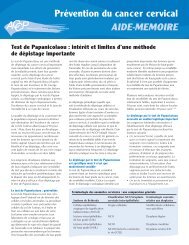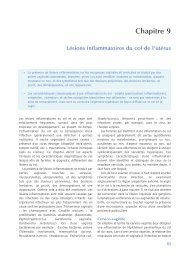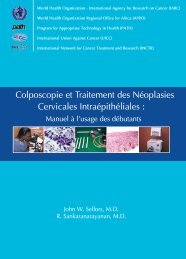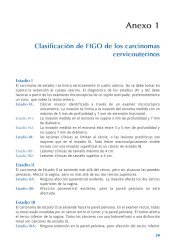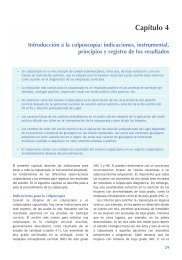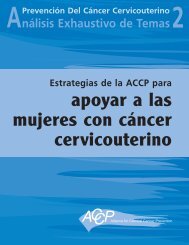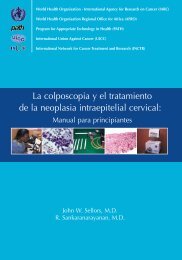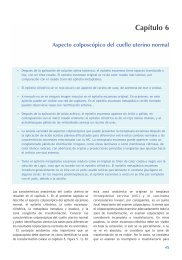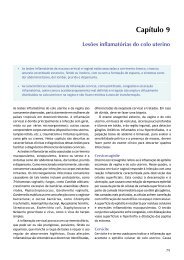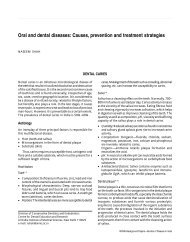Manual for Cytology - IARC Screening Group
Manual for Cytology - IARC Screening Group
Manual for Cytology - IARC Screening Group
Create successful ePaper yourself
Turn your PDF publications into a flip-book with our unique Google optimized e-Paper software.
Collection and Preparation of Material <strong>for</strong> Cytodiagnosis<br />
and syringe rinse preparations are routinely done and smears prepared by centrifugation or<br />
filtration. These types of indirect smears provide thin film of concentrated cells in a clear<br />
background from samples of low / high cellularity. This is ideal <strong>for</strong> special stains and<br />
immunocytochemistry.<br />
Note: In guided FNA, once the needle is in the mass, the procedure and smear preparation<br />
is similar to plain FNA, including the cutting motion with the needle as well as<br />
preparation and fixation of smears.<br />
Causes of unsatisfactory smears<br />
Unsatisfactory smears can be due to non-representative / inadequate samples or due to poor<br />
quality of preparation (thick smears, extreme admixture with blood, delayed fixation, over staining<br />
etc). Attention to matters of technique regarding the procedure and preparation of smears will<br />
considerably reduce the number of unsatisfactory smears received in a cytology lab.<br />
Clinical correlation and final interpretation by the pathologist<br />
Final diagnosis on FNA is based on clinical assessment prior to the aspiration procedure,<br />
observations during the procedure as well as microscopic evaluation. Optimal diagnosis is<br />
obtained when the same pathologist correlates the clinical features, per<strong>for</strong>ms the aspiration<br />
and evaluates the smears. When this is not possible, close communication between clinician<br />
and pathologist helps to maintain high quality of diagnosis and safeguards against errors.<br />
Inaccurate, misleading, incomplete or absent clinical in<strong>for</strong>mation can be important sources<br />
of error. Clinical in<strong>for</strong>mation is critical and is a part of FNA diagnosis as the morphological<br />
features may vary with the site of FNA and have to be correlated with the site of aspiration<br />
and other investigations <strong>for</strong> a meaningful diagnosis. Thus, systematic inclusion of clinical<br />
and lab data should be considered as part of the procedure. The technique (aspirator),<br />
morphological interpretation (pathologist) and clinical in<strong>for</strong>mation (clinician) constitute a<br />
diagnostic triad on which the FNA diagnosis rests.<br />
It is preferable not to report on technically poor slides or give a definite diagnosis without<br />
adequate clinical in<strong>for</strong>mation and correlation. Clinical data serves as a safeguard in avoiding<br />
errors.<br />
Other Quality control Measures<br />
In addition to details of technique (procedure, preparation, quality of materials used) and<br />
clinical correlation; other routine quality control practices regarding specimen reception<br />
(checking patient details, identification of slides, number of slides from each patient, labeling<br />
the slides), preparation and maintenance of stains, staining procedure, mounting, record<br />
keeping etc. are applicable to FNA also <strong>for</strong> optimal quality of diagnosis.<br />
21



